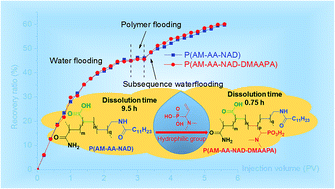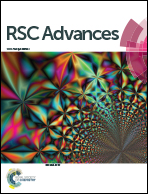A novel α-aminophosphonic acid-modified acrylamide-based hydrophobic associating copolymer with superb water solubility for enhanced oil recovery†
Abstract
As a non-renewable resource, the rational exploitation of oil has attracted a large amount of attention. Among many methods for enhanced oil recovery, polymer flooding is the most suitable method of chemical flooding for non-marine reservoirs and therefore various modified acrylamide-based copolymers have been studied. In this study, a novel α-aminophosphonic acid-modified hydrophobic associating copolymer was successfully synthesized by copolymerization of acrylamide, acrylic acid, N-allyldodecanamide and 1-(dimethylamino)allylphosphonic acid. The copolymer was characterized by FT-IR, 1H NMR and thermogravimetry and exhibited superior water solubility and thickening capability. Subsequently, the shear resistance, temperature resistance and salt tolerance of the copolymer solution were investigated. The value of apparent viscosity retention of a 2000 mg L−1 copolymer solution was as high as 58.55 mPa s at a shear rate of 170 s−1 and remained at 40.20 mPa s at 120 °C. The values of apparent viscosity retention of 55.41 mPa s, 59.95 mPa s and 52.97 mPa s were observed in solutions of 10 000 mg L−1 NaCl, 1200 mg L−1 MgCl2, and 1200 mg L−1 CaCl2, respectively. These were better than those of partially hydrolyzed polyacrylamide under the same conditions. In addition, an increase of up to 14.52% in the oil recovery rate compared with that for water flooding could be achieved in a core flooding test using a 2000 mg L−1 copolymer solution at 65 °C.


 Please wait while we load your content...
Please wait while we load your content...